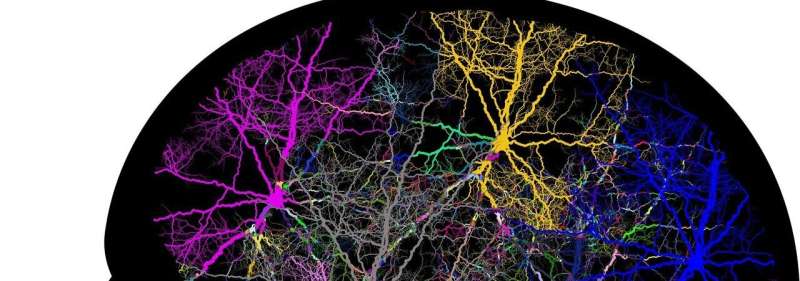This article has been reviewed according to Science X's editorial process and policies. Editors have highlighted the following attributes while ensuring the content's credibility:
fact-checked
trusted source
proofread
Dissecting the roles for excitatory and inhibitory neurons in STXBP1 encephalopathy

A recent study from Baylor College of Medicine and Texas Children's Hospital has discovered that inhibitory and excitatory neurons play distinct roles in the pathogenesis of STXBP1 encephalopathy, one of the top five causes of pediatric epilepsies and among the most frequent causes of neurodevelopmental disorders. This early-onset disorder is caused by spontaneous mutations in the syntaxin-binding protein 1 (STXBP1) gene.
While STXBP1 gene variants impair both excitatory and inhibitory neurotransmission, this study led by Dr. Mingshan Xue, associate professor at Baylor and principal investigator at the Jan and Dan Duncan Neurological Research Institute (Duncan NRI), finds that its loss from GABAergic inhibitory neurons has a more critical impact on the pathogenesis of STXBP1 disorder.
The paper was published in the Journal of Neuroscience.
By studying the affected cell types in greater detail and furthering our understanding of the underlying disease mechanisms, the study opens new opportunities to explore how the symptoms of this disorder can be modulated by specifically targeting these cell types, and will aid in the development of targeted therapeutic interventions.
Reduced functional STXBP1 protein in neurons causes STXBP1 encephalopathy
STXBP1 protein plays an essential role in synaptic vesicle exocytosis—the fundamental process by which all neurotransmitters are released from nerve cells. There are two major classes of neurotransmitters—the excitatory (e.g. glutamatergic) and inhibitory (e.g. GABAergic) neurotransmitters. Neurons releasing excitatory and inhibitory neurotransmitters are extensively interconnected throughout the brain and they act together to regulate brain activity and function.
In patients with this disorder, mutations in the STXBP1 gene result in an insufficient amount of functional STXBP1 protein in neurons causing symptoms such as severe cognitive impairments and psychiatric symptoms such as autism, hyperactivity, anxiety, and aggression. About 90% of affected individuals also develop motor dysfunction and seizures that could begin in infancy or later in life.
To understand the individual functional contributions of excitatory or inhibitory neurons in the pathogenesis of this disorder, Dr. Xue and his team created mouse models in which the expression of the STXBP1 gene was reduced to the levels seen in patients specifically in either glutamatergic or GABAergic neurons throughout major brain regions and studied its effect on epilepsy, cognitive, motor and psychiatric symptoms.
Loss of STXBP1 in excitatory or inhibitory neurons has distinct outcomes
"Since STXBP1 impacts the release of both these neurotransmitters equally, we expected that its loss in either population would result in overlapping and equally severe symptoms," said Dr. Joo Hyun Kim, lead author of the study and a postdoctoral fellow in the Xue lab.
"However, surprisingly, we found that reducing STXBP1 in GABAergic neurons recapitulated a majority of the symptoms seen in STXBP1 constitutive heterozygous knockout mice in which the expression of this gene is reduced in all neurons while inducing this mutation in glutamatergic neurons alone resulted in mice with fewer symptoms."
Thus, this study indicates that a reduction in inhibitory transmission plays a more critical role in the pathogenesis of this disorder by contributing to symptoms such as early lethality, developmental delay, impaired nest building, hyperactivity, motor dysfunction, aggression, impaired contextual fear memory, myoclonic seizures, hindlimb clasping, and anxiety-like behaviors whereas reduction of excitatory neurotransmission causes a subset of symptoms such as anxiety, social aggression, and absence seizures.
"Our study is the first such comprehensive analysis of the individual contributions of excitatory and inhibitory neurons in STXBP1 disorder," Dr. Xue said. "Our findings support the hypothesis that the impaired inhibitory neurotransmission is the primary disease mechanism in this disorder and offers researchers a new experimental framework to test the impact of modulators of both inhibitory and excitatory neurotransmitters to find customized treatments for each of these symptoms."
More information: Joo Hyun Kim et al, GABAergic/glycinergic and glutamatergic neurons mediate distinct neurodevelopmental phenotypes ofSTXBP1encephalopathy, The Journal of Neuroscience (2024). DOI: 10.1523/JNEUROSCI.1806-23.2024


















